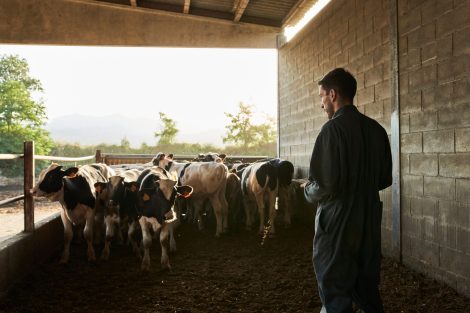High Pathogenicity Avian Influenza in Cattle

Updated on 8 May 2024
The ongoing spread of High Pathogenicity Avian Influenza (HPAI) in different regions of the world, alongside the recent detections of cases in cattle, is raising concerns within the international community.
While HPAI primarily affects poultry and wild birds, avian influenza can occasionally be transmitted to mammals, including humans. In the last two years, an increasing number of H5N1 avian influenza cases are being reported in terrestrial and aquatic mammalians animals.
The recently reported detections of HPAI in dairy cattle in the United States of America, have raised international concerns. Infected cattle may be asymptomatic or with mild illness showing non-specific clinical signs such as decreased milk production, thicker-colostrum‐like milk, reduced appetite, lethargy, fever and dehydration. These infections in cattle could indicate an increased risk of H5N1 viruses becoming better adapted to mammals, and potentially spilling over to humans and other livestock.
Initial investigations so far have revealed that raw milk from infected cows is a high-risk material. Thus, only milk produced by healthy cows should be commercialised. There are evidence of horizontal virus transmission from infected lactating cows to other animals including cows, cats and poultry. No specific adaptation of the virus to either humans or mammals was identified. Several studies are being carried out to further explore the pathogenesis and transmission routes of these viruses, including among cattle and from cattle to other animals.
In collaboration with its Reference Centres, our networks of experts and Members, the World Organisation for Animal Health (WOAH) is closely monitoring the situation to assess the risks to animals, but also to humans, which is currently considered low. Timely and transparent reporting is crucial to maintain a good understanding of the disease situation and prevent any type of misinformation or disinformation.
WOAH reminds its 183 Members that, based on the information currently available, restrictions to the international trade of healthy cattle and their products are not recommended unless justified by an import risk analysis conducted according to the WOAH Terrestrial Animal Health Code Chapter 2.1.
WOAH calls on its Members to:
- Maintain enhanced avian influenza SURVEILLANCE in domestic and wild birds.
- INCLUDE HPAI as a differential diagnosis, in non-avian species, including cattle and other livestock populations, with high risk of exposure to HPAI viruses, in particular:
- Animals showing clinical signs compatible with avian influenza;
- Sick or dead domestic animals near affected premises;
- Suspected, including apparently healthy animals, that have been exposed to or epidemiologically linked to suspected or confirmed HPAI in birds or cattle (i.e. situated in HPAI high-risk areas or in areas where avian influenza has been confirmed).
- REPORT cases of HPAI in all animal species, including unusual hosts, to WOAH through its World Animal Health Information System (WAHIS). Genetic sequences of avian influenza viruses should be shared in publicly available databases.
- CONSIDER poultry vaccination as complementary avian influenza control measure; PREVENT the introduction and spread of the disease by implementing strict biosecurity measures in livestock holdings, in particular in milking parlour and EMPLOY good production and hygiene practices when handling animal products. Raw milk or raw milk products from HPAI infected cows or exposed to those infected with HPAI should not be used to feed animals or for human consumption.
- PROTECT humans in close contact with or handling sick cattle or other sick livestock and their products. Exposed humans should always take precautionary measures to avoid getting infected and minimize the risk to mechanically carry the virus that could infect livestock or companion animals. This should include wearing personal protective equipment, avoiding visiting other livestock premises after the exposure and implementing standard food safety measures when handling animal products from exposed livestock.
- AVOID implementing unjustified trade restrictions. Import risk management measures should be scientifically justified and in line with the WOAH International Standards.
Technical guidelines for the adaptation of diagnostic tests for Influenza A in animals including cattle and other species as well as different types of samples such as milk and nasal swabs are available in the OFFLU website and will be regularly updated.
WOAH is fully committed to supporting its Members to mitigate the risks associated with avian influenza. We will continue to engage with our networks of experts, OFFLU, as well as public and private partners, notably through the One Health Quadripartite and the Global Framework for Transboundary Animal Diseases (GF-TADs) to provide technical updates as more information becomes available.
Resources
-
Highly Pathogenic Avian Influenza (HPAI) Detections in Livestock, USDA
-
Detection of Highly Pathogenic Avian Influenza in Dairy Herds: Frequently Asked Questions, USDA
-
Avian influenza in livestock case definition, USDA
-
Current H5N1 Bird Flu Situation in Dairy Cows | Avian Influenza (Flu), CDC
-
Updates on Highly Pathogenic Avian Influenza (HPAI), FDA
-
OFFLU dedicated webpage on HPAI detections in livestock
-
Avian Influenza, WOAH
